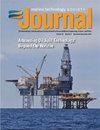A Mooring Development and Implementation Case Study of a Government/Private Partnership
IF 0.7
4区 工程技术
Q4 ENGINEERING, OCEAN
引用次数: 0
Abstract
Abstract In today's world where there is an increasing need to monitor and understand our changing oceans, under flat or shrinking budgets, it is challenging for a single organization to tackle problems of this scale and magnitude alone. Engineers and scientists from the National Oceantic and Atmospheric Administration's National Data Buoy Center (NDBC) and the Monterey Bay Aquarium Research Institute (MBARI) began a collaboration with this challenge in mind. The collaboration took advantage of each organization's strengths: MBARI has the capability to rapidly develop new instrument systems, and NDBC has the infrastructure on which to test their capabilities in the field. Here, we present development efforts that led to the deployment of a small partial pressure of carbon dioxide (pCO2) sensor system developed by MBARI on an NDBC buoy. The overarching goal was to demonstrate the utility of NDBC's new Auxiliary (Aux) module and determine the ease of adding third-party instrumentation to NDBC buoys. The Aux module is part of NDBC's latest generation of weather buoy data acquisition and reporting system, which provides more modularity and flexibility over previous systems. Given the large number of NDBC buoys currently in service, this capability opens up the possibility of a dense array of low-cost sensors to complement more highly specialized expensive mooring systems that are sparsely distributed. The partnership process led to the successful deployment of the pCO2 system on NDBC buoy 46013 off Bodega Bay, California, about 48 nautical miles northwest of San Francisco, for over a year of unattended operation. The technical and scientific results are described.政府/私营部门合作的系泊发展及实施个案研究
在当今世界,人们越来越需要监测和了解我们不断变化的海洋,在预算持平或缩减的情况下,单一组织独自解决这种规模和量级的问题是具有挑战性的。来自美国国家海洋和大气管理局国家数据浮标中心(NDBC)和蒙特利湾水族馆研究所(MBARI)的工程师和科学家们开始合作,考虑到这一挑战。这次合作充分利用了双方的优势:MBARI有能力快速开发新的仪器系统,而NDBC有基础设施来测试他们在该领域的能力。本文介绍了MBARI在NDBC浮标上开发的小型二氧化碳分压(pCO2)传感器系统的开发工作。总体目标是演示NDBC新辅助(Aux)模块的实用性,并确定向NDBC浮标添加第三方仪器的难易程度。Aux模块是NDBC最新一代气象浮标数据采集和报告系统的一部分,与以前的系统相比,它提供了更多的模块化和灵活性。鉴于目前大量的NDBC浮标在使用中,这种能力为密集的低成本传感器阵列提供了可能性,以补充更高度专业化的昂贵的系泊系统,这些系泊系统分布稀疏。这一合作过程使pCO2系统成功部署在加利福尼亚州Bodega湾附近的NDBC浮标46013上,该浮标位于旧金山西北约48海里处,在无人值守的情况下运行了一年多。叙述了技术和科学成果。
本文章由计算机程序翻译,如有差异,请以英文原文为准。
求助全文
约1分钟内获得全文
求助全文
来源期刊

Marine Technology Society Journal
工程技术-工程:大洋
CiteScore
1.70
自引率
0.00%
发文量
83
审稿时长
3 months
期刊介绍:
The Marine Technology Society Journal is the flagship publication of the Marine Technology Society. It publishes the highest caliber, peer-reviewed papers, six times a year, on subjects of interest to the society: marine technology, ocean science, marine policy, and education.
 求助内容:
求助内容: 应助结果提醒方式:
应助结果提醒方式:


